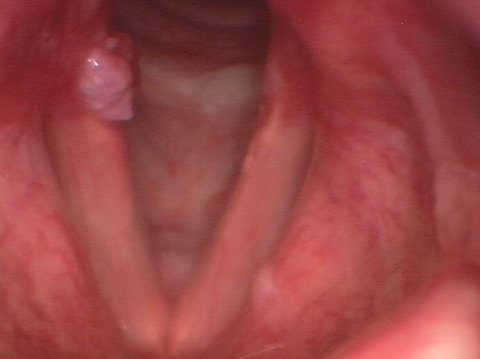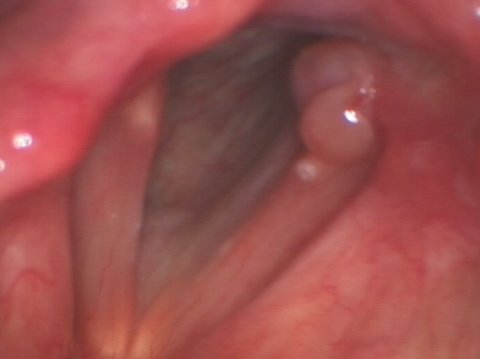What is a vocal cord granuloma?
A vocal cord granuloma (contact granuloma) is a tissue lesion (granulation tissue) of varying size and shape that usually occurs unilaterally in the posterior third of the vocal fold. Contact granulomas consist of inflammatory tissue that originates from the layer of dense fibrous connective tissue (perichondrium) lining the arytenoid cartilage. Vocal fold granulomas will commonly be shaped like a crater caused by them striking the contralateral side during phonation.
The size of contact granulomas varies greatly. In addition to the smaller forms that cause minor symptoms, there are large balloon-like granulomas that not only lead to significant hoarseness, but also to breathing problems.
Medium-sized contact granuloma


How does a vocal cord granuloma develop?
Almost always, a contact granuloma derives from an injury to the perichondrium, the layer covering the arytenoid cartilage. This damage is frequently due to mechanical overuse of the voice, in other words, from chronic or acute vocal strain. Hyperfunctional dysphonia is likewise another cause to be considered in the differential diagnosis. Laryngopharyngeal reflux (LPR) is also discussed a chemical cause of mucosal damage in this region.
The majority of contact granulomas are found in men; however, isolated cases of vocal fold granulomas have also been observed in women.
Psychogenic stress should be weighed into the diagnosis as factors or at least cofactors that may contribute to the development of a contact granuloma. This chiefly constitutes emotional stress and an aggressive personality structure.
When their medical history is taken, the patients frequently report having job-related or financial problems. In rare cases, professional singers can develop vocal fold granulomas. These cases are particularly difficult to manage because an automatic growth irritant is the intensive use of their singing voice, which is frequently also the reason why the contact granuloma increases in size. Even with intensive regimens of anti-reflux medicine and phases of vocal rest, granuloma treatment in professional singers is particularly difficult.
If the contact granuloma in a performing artist reaches a size that significantly impairs vocal fold closure and thereby causes permanent hoarseness, surgery must be considered as the “ultima ratio” or last resort.
Medium-sized contact granuloma


What symptoms are caused by a vocal cord granuloma?
- Abnormal sensations around the larynx
- Pronounced hoarseness
- Vocal fatigue
- Breathing complaints (in large granulomas)
Patients afflicted with a vocal cord granuloma frequently report having abnormal sensations around the larynx. This lump in the throat is called a globus sensation that is primarily noticed when swallowing. Further, a more or less pronounced hoarseness is the hallmark symptom.
These complaints can also be of a painful nature, with the patient requiring increasing effort to speak.
Additionally, patients frequently complain about vocal fatigue and a breathy voice quality, which is caused by incomplete vocal fold closure. The degree of breathiness usually increases proportionate with the size of the vocal cord granuloma.
In some cases, vocal cord granulomas can become so large that they obstruct the airways, leading the patients to complain about shortness of breath and breathing problems.

What treatment options are available for contact granulomas?
- Voice therapy
- Pharmacotherapy
- Voice surgery (limited indication)
The treatment of a vocal cord granuloma should basically follow a two-track strategy. On the one hand, an attempt should be made to help the patients produce a softer voice within a regimen of intensive voice therapy. They should also work on breaking their hyperfunctional pressure patterns, seeing as vocal fold granulomas usually originate from chronic voice overuse. Therefore, the patient should also be advised to use their voice as little as possible and, if appropriate, adhere to a several weeks’ period of vocal rest. On the other hand, the laryngopharyngeal reflux—a common co-factor in granuloma development—should undergo medical treatment. Pharmacotherapy with proton pump inhibitors, albeit at sufficiently high doses, is one option.
The treatment of a contact granuloma may be protracted. Once the granuloma has formed, quick and complete resolution is often difficult. Only a sustained combination of voice therapy and adequately dosed drug treatment will accomplish the objective.
Basically, vocal cord granulomas should not be operated on because they are subject to frequent recurrences. This can happen even just a few weeks after surgery. Since a contact granuloma is made up of inflammatory granulation tissue that originates from the perichondrium, surgery in this region frequently causes greater injury to the cartilage.
The tissue reaction of the cartilage injured during surgery can in turn result in the formation of excess inflammatory tissue, which is much larger than the original contact granuloma. A particular warning should be issued against attempts to remove a contact granuloma by laser treatment. Lasers rely on the generation of thermal energy and can thereby wreak significant thermal havoc on the perichondrium. The resultant recurrences can take on considerable proportions. Therefore, the benefits of any operative treatment of vocal fold granulomas should be weighed very judiciously.

Truths and Myths About Vocal Cord Granulomas
Triggered by mucosal injury to the vocal process (arytenoid cartilage), contact granulomas grow from excessive infiltration by inflammatory tissue. The mucosal injury involved is observed in many variations. Voice overuse, chronic cough, severe laryngopharyngeal reflux as well as psychogenic co-factors all play key roles to varying degrees.
The hypothesis that a contact granuloma is almost always based on a psychogenic disorder or emotional dysbalance is definitively not consistent with Dr. Wohlt’s personal experience.

Case Report: Contact Granuloma
A 44-year-old labor union official presented with hoarseness that had existed for six months. At the onset, his voice was initially only slightly veiled. Over the course of months, however, it developed a significant hoarseness. Along with this voice impairment, he reported an abnormal sensation—like a lump in his throat—that he mostly noticed when swallowing. Speaking was difficult, his voice tired much faster than before, and he was no longer able to shout loudly at all.
The patient was a non-smoker; for around two years now, his work as an official had been especially strenuous, his workload very heavy and associated with great psychological stress. This overwork was affecting his family life and his social contacts were falling by the wayside.
The videostroboscopic examination showed a pronounced vocal cord granuloma on the right vocal process, i.e. in the posterior third of the vocal fold, presenting with the characteristic crater-like shape. The arytenoid cartilage on the contralateral side exhibited minor tissue hyperplasia. During voice production, both his vocal folds were no longer able to close completely because of the blockage caused by the contact granuloma.
The patient was advised to submit himself a two-track treatment regimen. First, intensified voice therapy was initiated that took place twice a week. The aim here was to teach the patient to produce a softer voice and apply less pressure in doing so. In addition, the patient was prescribed a high-dose proton pump inhibitor. Every two months, he came to laryngological check-up examinations. After an initially successful therapeutic outcome with marked resolution of the contact granuloma, he suffered a major recurrence another two months later.
A supportive psychotherapeutic intervention was started; complete resolution of the contact granuloma was diagnosed four months later. It is interesting to note here that success was not achieved in this patient until functional voice therapy, anti-reflux medication and a supportive psychotherapeutic intervention were combined.




